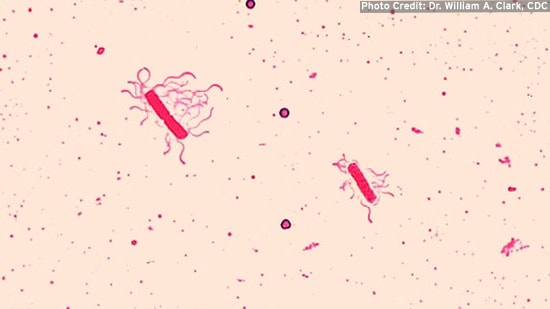
Bacillus cereus
What is Bacillus cereus?
Bacillus cereus is a spore-forming bacterium that can be frequently isolated from soil and some food.1 B. cereus spores are more resistant to heat and chemical treatments than vegetative pathogens such as Salmonella, E. coli, Campylobacter, and Listeria monocytogenes. If B. cereus grows in food, it can cause two different types of foodborne illness in humans – vomiting very shortly after eating contaminated food or diarrhea after a longer incubation.
WHAT ARE THE SYMPTOMS?
Two different toxins are involved in these foodborne illnesses. The emetic (vomiting) form of B. cereus has an onset time of 0.5 to 6 hours after consumption, with primary symptoms of vomiting and nausea and occasionally diarrhea. Recovery occurs in less than 24 hours. The diarrheal illness has a mean onset time of between 6 and 15 hours, with symptoms of watery diarrhea, pain and nausea persisting for 24 hours. The diarrheal toxin is released in the body after ingestion of high numbers of cells (e.g. >105/g).2 It is the action of the toxin in the small intestine that causes diarrhea. In a small percentage of cases, both vomiting and diarrheal symptoms can occur if both types of toxins are produced.
HOW IS Bacillus cereus TRANSMITTED?
Spores of B. cereus can be found widely in nature, including samples of dust, dirt, cereal crops, water, etc., so it is a common contaminant of raw agricultural commodities. Normal contamination levels are generally <100.3
Starchy foods, such as rice or potatoes, are commonly associated with B. cereus emetic (vomiting) toxin outbreaks. Due to its preparation process, one of the most common food vehicles for transmission of emetic B. cereus illness is fried rice, and there have been several reported outbreaks. The spores of B. cereus are activated in the initial preparation of the rice, which if stored at abusive temperatures (approximately 59 to 104°F or 15 to 40°C) for an extended time, will outgrow and produce a toxin that is heat stable and will not be inactivated during subsequent cooking.
The diarrhea-causing strains have been found in a wider selection of foods. Common sources include meat and vegetable items, soups and milk products. Unlike the emetic toxin, the diarrheal toxin is destroyed in cooking.4 If the spores experience conditions that permit growth, they can grow to levels where toxins are produced.
The types of B. cereus illness reported appear to differ significantly by geography. In Japan, the emetic form is found about 10 times more frequently than the diarrheal type.5 In Europe and North America, the diarrheal type is more frequently reported.6 These differences may be due to variations in diet among the world’s regions.
HOW IS Bacillus cereus CONTROLLED?
Heating can activate spores, which allows them to germinate and grow under favorable conditions. Time and temperature abuse of cooked food permits the activated spores to grow and produce toxins. Control relies on prompt refrigeration and cooling of foods quickly to less than 41°F (5°C) to minimise growth and toxin formation. Many of the emetic illnesses are due to improper holding of cooked rice at warm room temperatures, offering conditions where the activated spores in the rice are able to produce toxin. Foods should be promptly refrigerated or held above 140°F (60°C) to prevent growth of the cells.
Heating of a food after potential temperature abuse is not a foolproof control technique for B. cereus, since the emetic toxin is heat stable. The diarrheal toxin will, however, be destroyed by heating.
An additional concern regarding B. cereus is the resistance of the spores to peracetic acid treatments that may be used as an alternative to hydrogen peroxide for treatment of aseptic packaging materials. B.cereus spores are more resistant to some peracid products than other sporeformers.7 If the food product to be produced supports the growth of B. cereus, it is important to evaluate effectiveness of the treatment against B. cereus spores to ensure product safety.
REFERENCES AND FURTHER INFORMATION
1. International Commission on Microbiological Specifications for Foods. Microorganisms in Foods 5, Characteristics of Microbial Pathogens. Blackie Academic and Professional, New York. 1996. Pages 20 -35.
2. Kramer, J.M. and R.J. Gilbert. Bacillus cereus and other Bacillus species. InM.P. Doyle (ed.) Foodborne Bacterial Pathogens. Marcel Dekker, New York, NY. 1989. Pages 21-70.
1Kramer, J.M. and R.J. Gilbert. 1989. Bacillus cereus and other Bacillus species, p. 21-70. In M.P. Dyle (ed.) Foodborne Bacterial Pathogens. Marcel Dekker, New York, NY.
2Johnson, K.M. 1984. Bacillus cereus Foodborne Illness – An Update. J. Food Protect. 47:145-53.
3Hobbs, B.C. and Gilbert, R. J. 1974. ‘Microbiological Counts in relation to food poisoning’, Proceedings of the IV international Congress of Food Science Technology 3:159.
4Gilbert, R. J. 1979. Bacillus cereus gastroenteritis. In “Food-borne Infections and Intoxications,” 2nded., p. 495. Ed. Reimann, H and Bryan, F.L. Academic Press, Inc., New York, NY.
5Shinagawa, K. 1993. Serology and characteristics of Bacillus cereus in relation to toxin production. Bull. Int. Dairy Fed. 287:42-49.
6Aas, N. B. Gondronsen and G. Langeland. 1992. Norwegian Food Control Authority’s Report on Food Associated Diseases in 1990. SNT-report 3, Norwegian Food Control Authority, Oslo, Norway.
7Blakistone, B. R. Chuyate, D. Kautter, jr., J. Charbonneau, and K. Suit. 1999. Efficacy of Oxonia Active against selected spore formers. J. Food Protect. 62: 262-7.


